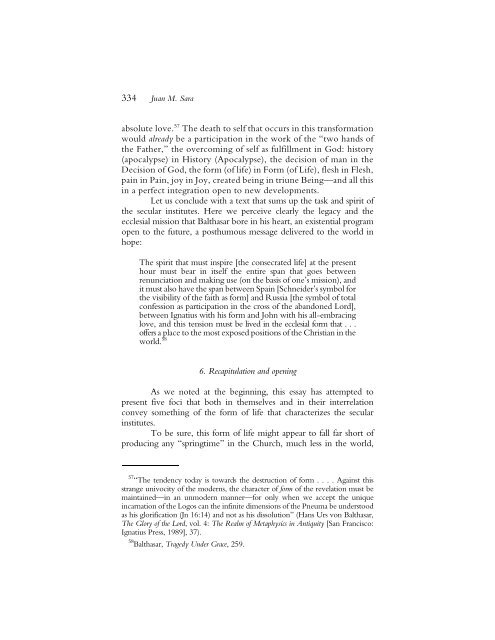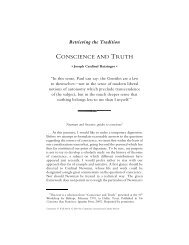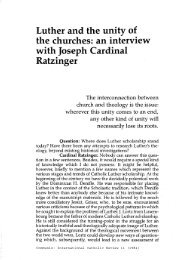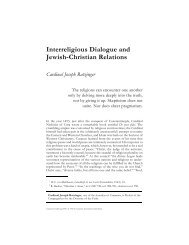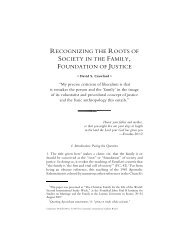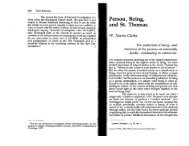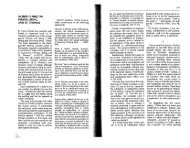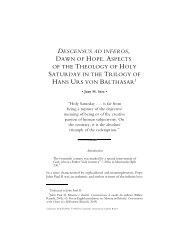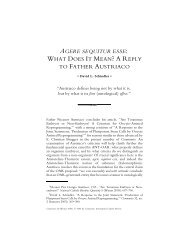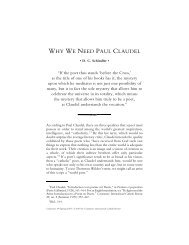Juan Sara. Secular Institutes According to Hans Urs ... - Communio
Juan Sara. Secular Institutes According to Hans Urs ... - Communio
Juan Sara. Secular Institutes According to Hans Urs ... - Communio
You also want an ePaper? Increase the reach of your titles
YUMPU automatically turns print PDFs into web optimized ePapers that Google loves.
334 <strong>Juan</strong> M. <strong>Sara</strong><br />
absolute love. 57 The death <strong>to</strong> self that occurs in this transformation<br />
would already be a participation in the work of the “two hands of<br />
the Father,” the overcoming of self as fulfillment in God: his<strong>to</strong>ry<br />
(apocalypse) in His<strong>to</strong>ry (Apocalypse), the decision of man in the<br />
Decision of God, the form (of life) in Form (of Life), flesh in Flesh,<br />
pain in Pain, joy in Joy, created being in triune Being—and all this<br />
in a perfect integration open <strong>to</strong> new developments.<br />
Let us conclude with a text that sums up the task and spirit of<br />
the secular institutes. Here we perceive clearly the legacy and the<br />
ecclesial mission that Balthasar bore in his heart, an existential program<br />
open <strong>to</strong> the future, a posthumous message delivered <strong>to</strong> the world in<br />
hope:<br />
The spirit that must inspire [the consecrated life] at the present<br />
hour must bear in itself the entire span that goes between<br />
renunciation and making use (on the basis of one’s mission), and<br />
it must also have the span between Spain [Schneider’s symbol for<br />
the visibility of the faith as form] and Russia [the symbol of <strong>to</strong>tal<br />
confession as participation in the cross of the abandoned Lord],<br />
between Ignatius with his form and John with his all-embracing<br />
love, and this tension must be lived in the ecclesial form that . . .<br />
offers a place <strong>to</strong> the most exposed positions of the Christian in the<br />
world. 58<br />
6. Recapitulation and opening<br />
As we noted at the beginning, this essay has attempted <strong>to</strong><br />
present five foci that both in themselves and in their interrelation<br />
convey something of the form of life that characterizes the secular<br />
institutes.<br />
To be sure, this form of life might appear <strong>to</strong> fall far short of<br />
producing any “springtime” in the Church, much less in the world,<br />
57 “The tendency <strong>to</strong>day is <strong>to</strong>wards the destruction of form . . . . Against this<br />
strange univocity of the moderns, the character of form of the revelation must be<br />
maintained—in an unmodern manner—for only when we accept the unique<br />
incarnation of the Logos can the infinite dimensions of the Pneuma be unders<strong>to</strong>od<br />
as his glorification (Jn 16:14) and not as his dissolution” (<strong>Hans</strong> <strong>Urs</strong> von Balthasar,<br />
The Glory of the Lord, vol. 4: The Realm of Metaphysics in Antiquity [San Francisco:<br />
Ignatius Press, 1989], 37).<br />
58 Balthasar, Tragedy Under Grace, 259.


